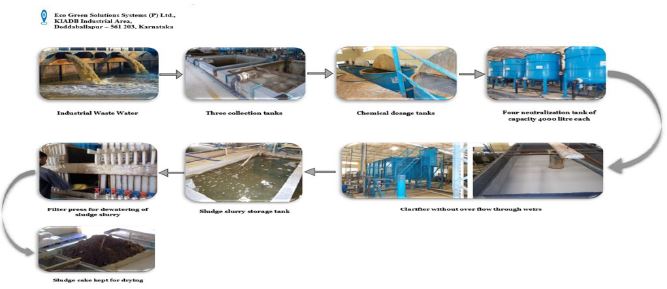Innovative Waste Management: Incorporating CETP Sludge in Concrete for Sustainable Construction
DOI:
https://doi.org/10.5281/zenodo.14061517Keywords:
industrial waste, sustainable construction, fine aggregate replacement, cetp sludgeAbstract
In response to growing concerns about environmental sustainability and waste management, the exploration of alternative construction materials has gained prominence. One such alternative is common effluent treatment plant (CETP) sludge, a by-product of industrial wastewater treatment that poses significant environmental challenges. This study aims to evaluate the feasibility of substituting conventional fine aggregate with CETP sludge in concrete mixtures, addressing waste disposal issues and enhancing the sustainability of concrete construction. The research investigates the physical, chemical, and mechanical properties of CETP sludge to determine its suitability as a partial replacement for fine aggregate. Concrete mixtures with varying percentages of CETP sludge (0%, 10%, 20%, 30%, 40%, 50%) will be prepared and evaluated for compressive strength, durability, and workability. The study examines the potential benefits and challenges of incorporating CETP sludge, including its environmental impact, cost-effectiveness, and regulatory compliance. Initial findings suggest that CETP sludge possesses properties that make it a promising candidate for partial fine aggregate replacement. Further investigation will focus on its effect on the fresh and hardened properties of concrete, determining the optimal replacement ratio for desired performance. Environmental assessments will also be conducted to gauge the overall sustainability of concrete mixtures containing CETP sludge. This study aims to provide a novel solution for the responsible disposal of CETP sludge and promote environmentally friendly alternatives in construction. The research will explore the specific mechanical and durability properties of concrete with 10% CETP sludge replacement, aiming to identify an optimal balance between environmental benefits and structural integrity. The outcomes will contribute valuable insights into sustainable construction practices, encourage waste utilization in a circular economy, and reduce the environmental footprint of concrete materials.
Downloads
References
Cheng, Zhiqing, et al. (2023). Effect of textile sludge on strength, shrinkage, and microstructure of polypropylene fibber concrete. Buildings.
Sharma, Prateek Kumar, et al. (2021). Properties of concrete containing industrial waste as a fine aggregate. Community Based Research and Innovations in Civil Engineering, 796. Published by IOP Publishing Ltd.
Kaish, A.B.M.A., et al. (2021). Effects of different industrial waste materials as partial replacement of fine aggregate on strength and microstructure properties of concrete. Journal of Building Engineering, 35.
Loganayagan, et al. (2020). Experimental study on concrete by partial replacement of fine aggregate by textile effluent treatment plant sludge. IOP Conference Series: Materials Science and Engineering, 764.
Rahman, Md. Mostafizur, et al. (2017). Textile effluent treatment plant sludge: Characterization and utilization in building materials. Arabian Journal for Science and Engineering, 42, 1435-1442.
Dash, Manoj Kumar, et al. (2016). Sustainable use of industrial-waste as partial replacement of fine aggregate for preparation of concrete. International Journal of Sustainable Built Environment, 5(2), 484-516.
Zhan, Baojian, et al. (2015). Study on feasibility of reutilizing textile effluent sludge for producing concrete blocks. Journal of Cleaner Production, 101, 174-179.
Kaish, A.B.M.A., et al. (2018). Influence of pre-treated alum sludge on properties of high-strength self-compacting concrete. Journal of Cleaner Production, 202, 1085-1096.
Wang, Lei, et al. (2018). A novel type of controlled low strength material derived from alum sludge and green materials. Construction and Building Materials, 165, 792-800.
Raghunathan, et al. (2010). Study on strength of concrete with ETP sludge from dyeing industry. International Journal of Civil and Structural Engineering, 1, 379-389.
Jamshidi, A., et al. (2011). Application of sewage dry sludge as fine aggregate in concrete. Journal of Environmental Studies.
Patel, Hemangi, et al. (2009). Exploring the reuse potential of chemical sludge from textile wastewater treatment plants in India—A hazardous waste. American Journal of Environmental Sciences, 5, 106-110.
Jayakumar, P., et al. (2013). Experimental investigation on paver blocks using steel slag as partial replacement of aggregate and sludge as partial replacement of cement.

Published
How to Cite
Issue
Section
ARK
License
Copyright (c) 2024 Sandeep Kumar C, Dr. Usha S, Dr. Shivaraju G D

This work is licensed under a Creative Commons Attribution 4.0 International License.
Research Articles in 'Applied Science and Engineering Journal for Advanced Research' are Open Access articles published under the Creative Commons CC BY License Creative Commons Attribution 4.0 International License http://creativecommons.org/licenses/by/4.0/. This license allows you to share – copy and redistribute the material in any medium or format. Adapt – remix, transform, and build upon the material for any purpose, even commercially.










